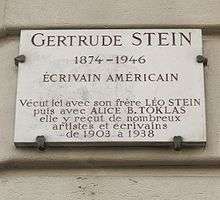27 rue de Fleurus

27 rue de Fleurus is the location of the former home of Gertrude Stein and Alice B. Toklas in the 6th arrondissement of Paris on the Left Bank of Paris. It was also the home of Leo Stein for a time in the early nineteen-hundreds. It was a renowned Saturday evening gathering place for both expatriate American artists and writers and others noteworthy in the world of vanguard arts and letters, most notably Pablo Picasso. In the early decades of the century, hundreds of visitors flocked to the display of vanguard modern art, many came to scoff, but several went away converted.
Entrée into the Stein salon was a sought-after validation, and Stein became combination mentor, critic, and guru to those who gathered around her, including Ernest Hemingway, who described the salon in A Moveable Feast. The principal attraction was the collection of Paul Cézanne oils and watercolors and the early pictures by Henri Matisse and Pablo Picasso which Gertrude and Leo had had the funds and the foresight to buy. The walls of their atelier at 27 rue de Fleurus were hung to the ceiling with now-famous paintings, the double doors of the dining room were lined with Picasso sketches. On a typical Saturday evening one would have found Gertrude Stein at her post in the atelier, garbed in brown corduroy, sitting in a high-backed Renaissance chair, her legs dangling, next to the big cast-iron stove that heated the chilly room. A few feet away, Leo Stein would expound to a group of visitors his views on modern art.
In 1933, Stein published a kind of memoir of her Paris years, The Autobiography of Alice B. Toklas, written in the voice of Toklas, her life partner. The book became a literary bestseller and vaulted Stein from the relative obscurity of cult literary figure into the light of mainstream attention.[1]
The gatherings in the Stein home "brought together confluences of talent and thinking that would help define modernism in literature and art." Dedicated attendees included Pablo Picasso, Ernest Hemingway, F. Scott Fitzgerald, Guillaume Apollinaire, Sinclair Lewis, James Joyce, Ezra Pound, Thornton Wilder, Juan Gris, Sherwood Anderson, Francis Cyril Rose, René Crevel, Élisabeth de Gramont, Francis Picabia, Claribel Cone, Mildred Aldrich, Carl Van Vechten and Henri Matisse.[2] Saturday evenings had been set as the jour fixe for formal congregation so Stein could work at her writing uninterrupted by impromptu visitors. It was Stein's partner Toklas who became the de facto hostess for the wives and girlfriends of the artists in attendance, who met in a separate room.
Stein herself attributed the beginnings of the Saturday evening salons to Matisse, as
[m]ore and more frequently, people began visiting to see the Matisse paintings—and the Cézannes: "Matisse brought people, everybody brought somebody, and they came at any time and it began to be a nuisance, and it was in this way that Saturday evenings began."[3]
Among Picasso's acquaintances who frequented the Saturday evenings were: Fernande Olivier (Picasso's mistress), Georges Braque (artist), André Derain (artist), Max Jacob (poet), Guillaume Apollinaire (poet), Marie Laurencin (artist, and Apollinaire's mistress), Henri Rousseau (painter), and Joseph Stella.[4]
The 2014 opera 27 by Ricky Ian Gordon and Royce Vavrek is inspired by events at 27 rue de Fleurus.
References
- ↑ Books – Mellow, James R., "The Stein Salon Was the First Museum of Modern Art", The New York Times. December 1, 1968, retrieved October 13, 2012
- ↑ http://www.brbl-archive.library.yale.edu, "Extravagant Crowd: Gertrude Stein and Alice B. Toklas," retrieved October 16, 2012
- ↑ Mellow (1974), p. 84.
- ↑ Mellow (1974), pp. 94–95.
- Mellow, James R. (1974), Charmed Circle: Gertrude Stein & Company, New York, Washington: Praeger Publishers, ISBN 0-395-47982-7
External links
 Media related to 27 rue de Fleurus, Paris at Wikimedia Commons
Media related to 27 rue de Fleurus, Paris at Wikimedia Commons
Coordinates: 48°50′49″N 2°19′45″E / 48.8469°N 2.3293°E